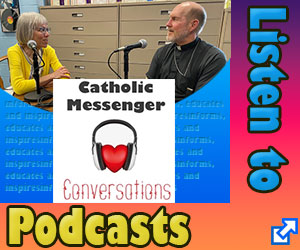By Celine Klosterman
Lay ministry is a growing movement that church leaders and parishioners must embrace, and the church is called to welcome diverse peoples, three Diocesan Planning Commission members learned at conferences they attended last month.
Father Jim Vrba and Father Tony Herold attended the National Federation of Priests’ Councils 2009 convention in San Antonio and Sister Laura Goedken, OP, took part in the National Pastoral Life Center’s 2009 conference on pastoral planning in Plymouth, Mich. (Father Walter Helms, not a commission member, also attended the priests’ convention.) Both conferences addressed the future of parishes — a topic germane to the Davenport Diocese’s commission, which is developing a plan for parish and deanery structuring through 2020 amid a priest shortage.
Development of lay ministry is like the historical development of religious orders, said Edward Hahnenberg, a speaker at the priests’ conference and an associate professor of theology at Xavier University in Cincinnati. Fr. Vrba, commission co-chair, appreciated that insight.
“The Holy Spirit is still calling people to ministry in the church, and many are responding,” the priest said. “We obviously need to keep actively praying and encouraging vocations to priesthood, but we also need to acknowledge and be thankful for those who are responding to the additional calls of the Holy Spirit.”
Like members of religious orders, lay ministers were treated with suspicion at first, said Hahnenberg. But bishops and pastors must promote lay ministry. Its growth depends on clergy embracing it, “not seeing it as a temporary solution until the priest shortage ends,” a press release quoted him as saying. Like St. Paul, priests don’t work alone, Hahnenberg said. The saint’s writings name 95 collaborators.
All Catholics are called to evangelize, Father Allan Figueroa Deck, SJ, said at the conference. Lay Catholics act “not in competition, but in complementarity to the charism of the priest.”
Priests are most effective “when they see themselves as part of the Christian family, not set apart from or above others,” said Cardinal Roger Mahony of Los Angeles.
Increased lay leadership is one of several new paradigms emerging, Sr. Goedken recalled presenter Marti Jewell saying at the pastoral planning conference. Jewell directs the Emerging Models of Pastoral Leadership Project, a joint effort of the National Association for Lay Ministry and five other national Catholic associations.
The church will continue including diverse peoples and forms of leadership, be mission-focused and justice oriented, and vibrant and welcoming with small, faith-based communities, Jewell said.
Despite our differences, we’re all brothers and sisters in Christ, Bishop Daniel Flores of Detroit said at the conference. The church is us, not we and they.
“We need to think of unity in the church,” said Sr. Goedken.
To bring cultures together in parishes, recognize what each culture appreciates. Let the people teach you, Sr. Goedken shared, recalling Bishop Flores’ presentation. And begin with a devotion to Our Lady and to the Eucharist, which all Catholic cultures have in common.
Tensions between church members can be resolved if the members can serve each other, writer Father Ron Rolheiser, OMI, said at the priests’ conference. “Common ground is found in humility and a willingness to serve.”
We should let God stretch us beyond our concepts of who should and shouldn’t receive ministry from us so we can truly be instruments of salvation, Fr. Rolheiser said later.
Fr. Deck offered perspective for those working to be such instruments. The church must follow Jesus’ mission, not vice versa, he said. “The mission has a church!”








